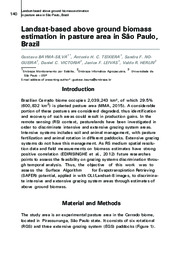Landsat-based above ground biomass estimation in pasture area in São Paulo, Brazil.
Landsat-based above ground biomass estimation in pasture area in São Paulo, Brazil.
Summary: Brazilian Cerrado biome occupies 2,039,243 km², of which 29.5% (600,832 km2) is planted pasture area (MMA, 2015). A considerable portion of these pastures are considered degraded, thus identification and recovery of such areas could result in production gains. In the remote sensing (RS) context, pasturelands have been investigated in order to discriminate intensive and extensive grazing system areas. Intensive systems includes soil and animal management, with pasture fertilization and animal rotation in different paddocks. Extensive grazing systems do not have this management. As RS medium spatial resolution data and field measurements on biomass estimates have strong positive correlation (EDIRISINGHE et al., 2012) future researches points to assess the feasibility on grazing systems discrimination through temporal analysis. Thus, the objective of this work was to assess the Surface Algorithm for Evapotranspiration Retrieving (SAFER) potential, applied in with OLI/Landsat-8 images, to discriminate intensive and extensive grazing system areas through estimates of above ground biomass.
Publication year: 2016
Types of publication: Paper in annals and proceedings
Unit: Embrapa Territorial
Observation
Some of Embrapa's publications are published as ePub files. To read them, use or download one of the following free software options to your computer or mobile device. Android: Google Play Books; IOS: iBooks; Windows and Linux: Calibre.
Access other publications
Access the Agricultural Research Database (BDPA) to consult Embrapa's full library collection and records.
Visit Embrapa Bookstore to purchase books and other publications sold by Embrapa.

